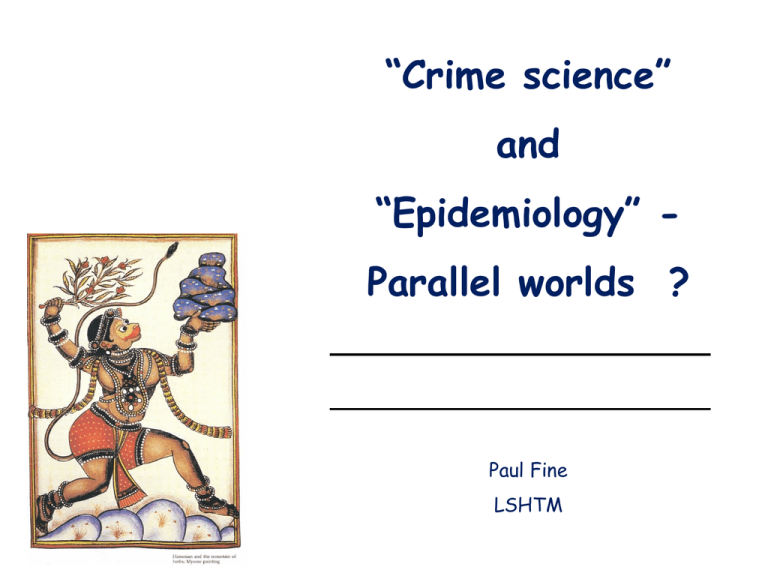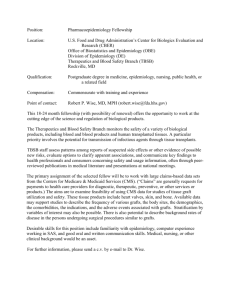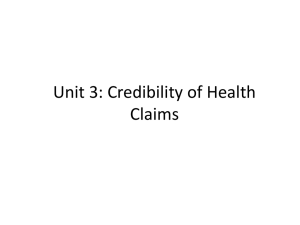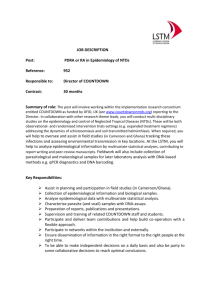Slide download: Crime science and epidemiology UCL SECReT
advertisement

“Crime science” and “Epidemiology” - Parallel worlds ? Paul Fine LSHTM Outline • background • words • history • methods > applications • implications Words … • “Crime science” • “Epidemiology” ‘epidemiology’ - etymology epi = upon demos = people ology = logic, study Hippocrates (c. 460 BCE) used the terms: epidemion : for diseases that visited the population – hence our word “epidemic” endemion : for diseases that resided in the population – hence our word “endemic” ‘epidemiology’ - current definitions: • “Epidemiology is the study of health-event, health-characteristic, or health-determinant patterns in a society. It is the cornerstone method of public health research” (Wikipedia ) • “The study of the distribution and determinants of health-related states or events in specified populations, and the application of this study to the control of health problems” (Last J, Dictionary of Epidemiology) ‘epidemiology’ - current definitions: • “Epidemiology is the study of health-event, health-characteristic, or health-determinant patterns in a society. It is the cornerstone method of public health research” (Wikipedia ) • “The study of the distribution and determinants of health-related states or events in specified populations, and the application of this study to the control of health problems” (Last J, Dictionary of Epidemiology) Emphasis on health (and disease ) dates back to Hippocrates ‘epidemiology’ - current definitions: • “Epidemiology is the study of health-event, health-characteristic, or health-determinant patterns in a society. It is the cornerstone method of public health research” (Wikipedia ) • “The study of the distribution and determinants of health-related states or events in specified populations, and the application of this study to the control of health problems” (Last J, Dictionary of Epidemiology) Emphasis on health (and disease ) dates back to Hippocrates That’s too bad - as word and methods apply to anything in a population “London Epidemiological Society” 1850 - 1907 Anonymous letter (signed “Pater”) to Lancet in 1848 "Will that dreadful scourge the cholera visit our island again ? If so, are medical men prepared to wage a war against it ? …. meetings should be held in different localities…." Led to first gathering, in 1850 – in Hanover Square About 100 physicians met (including John Snow, William Farr, William Budd, Thomas Addison, Thomas Babington, …) Society’s name - first use of word “epidemiological” Medical emphasis throughout society’s history …. “London Epidemiological Society” 1850 - 1907 Anonymous letter (signed “Pater”) to Lancet in 1848 "Will that dreadful scourge the cholera visit our island again ? If so, are medical men prepared to wage a war against it ? …. meetings should be held in different localities…." Led to first gathering, in 1850 – in Hanover Square About 100 physicians met (including John Snow, William Farr, William Budd, Thomas Addison, Thomas Babington, …) Society’s name - first use of word “epidemiological” Medical emphasis throughout society’s history …. John Snow - local hero and “father” of epidemiology GP in Soho (Frith Street) interested in asphyxia of newborns … witnessed one of first uses of ether anaesthesia - 28 December 1846 (by James Robinson – dentist on Gower Street) recognised importance of ambient temperature tabulated vapour pressure of ether - 16 January 1847 became well known anaesthetist… and authority on behaviour of gasses leading him to argue against miasma theory of cholera ! ! John Snow and Cholera 1849 - 54 Ovelapping pipe networks of two water companies (Lambeth and Southwark & Vauxhall) south of Thames. The Lambeth Company (red) moved source upstream in 1852 – Snow predicted lower cholera risk in houses served by that company – confirmed 1854 Outbreak in Soho, August-September 1854, clustered around water pump – “... and because of what I said, the handle of the pump was removed.” Note Snow’s “Voronoi diagram” – a cartographical first ! “Snow’s law” The successful public health epidemiologist arrives after the peak, and rides the downslope home to glory…. A few people saw broad implications Eg Ronald Ross (2nd Nobel Laureate in Medicine - 1902) From Appendix entitled: “Theory of happenings” in 2nd edition of his book “The Prevention of Malaria” (1911) “We shall deal with time to time variations not only of malaria, but of all disease, and not only of diseases of man, but those of any living organisms. Still further, as infection is only one of many kids of events which may happen to such organisms, we shall deal with happenings in general.” Epidemiology – as an academic discipline Departments of Epidemiology (in schools of public health) eg London School of Hygiene and Tropical Medicine Division (and Professor) of Epidemiology and Vital Statistics (Major Greenwood) - 1927 Johns Hopkins School of Public Health – Baltimore USA first Department of Epidemiology - 1919 first Professor of Epidemiology – 1930 Major growth after WWII Departments and teaching typically linked with medical statistics … Some Textbooks (with epidemiology in the title) A natural affinity... • Disease and crime, by definition, are conditions which all societies seek to minimise .... • Similar vocabulary: Crime as a disease.... a “cancer”... an epidemic ; susceptibility as victimhood.... • Epidemiologists as “medical detectives” • Importance of evaluating prevention and treatment protocols .... Drug Addiction, Crime or Disease? Interim and Final Reports of the Joint Committee of the American Bar Association and the American Medical Association on Narcotic Drugs. Theory of crime epidemic: What is “dispositional” explanation for events? Posted by: adonis49 on: June 28, 2011 Epidemiology – as methodology (for studying things in populations ) Typical epidemiology course syllabus (at least in health context): • data collection and quality • basic study designs and logic • analytic methods • “special” techniques • ethics Epidemiology – as methodology (for studying things in populations ) Typical epidemiology course syllabus (at least in health context): • data collection and quality • basic study designs and logic • analytic methods • “special” techniques • ethics Data collection and quality • Routine (notifications) vs active collection • Sampling • Questionnaires (design and administration) • Measurement • Random versus systematic error (“bias”) • Validity - sensitivity and specificity • Repeatability • Validation ….. eg range and cross checks • Missing data and imputation Data collection and quality • Routine (notifications) vs active collection • Sampling • Questionnaires (design and administration) • Measurement • Random versus systematic error (“bias”) • Validity - sensitivity and specificity • Repeatability • Validation ….. eg range and cross checks • Missing data and imputation Aren’t these just fancy words for … “trained and organised common sense” ? Study designs and logic Epidemiological studies “Observational” “Intervention” “Descriptive” Cross-sectional survey Longitudinal Survey “Analytical” Ecological (correlation) Study Cohort Study Casecontrol Study Clinical or Community Trial Study designs and logic Epidemiological studies “Observational” “Intervention” “Descriptive” Cross-sectional survey Longitudinal Survey “Analytical” Ecological (correlation) Study Cohort Study Casecontrol Study Clinical or Community Trial Study designs and logic Epidemiological studies “Observational” “Intervention” “Descriptive” What... Who... When How many...... Where ... Cross-sectional survey Longitudinal Survey “Analytical” How... Why.. Ecological (correlation) Study Cohort Study Casecontrol Study Clinical or Community Trial “Descriptive” studies • cross sectional surveys An examination of the health and wellbeing of childless women: A cross-sectional exploratory study in Victoria, Australia. Graham ML, Hill E, Shelley JM, Taket AR. BMC Womens Health. 2011 Nov 10;11(1):47. Economics Letters 96 (2007) 264 – 268 Does income inequality lead to more crime? A comparison of cross-sectional and time-series analyses of United States counties. Jesse Brush Yale Law School, 76 Westland Road, Weston, 02493 MA, USA • longitudinal follow-up studies A prospective longitudinal study of children's theory of mind and adolescent involvement in bullying. Shakoor S, Jaffee SR, Bowes L, Ouellet-Morin I, Andreou P, Happé F, Moffitt TE, Arseneault L. J Child Psychol Psychiatry. 2011 Nov 14. doi: 10.1111/j.1469-7610.2011.02488.x. Trajectories of crime at places: a longitudinal study of street segments in the city of Seattle David Weisburd, Shawn Bushway, Cynthia Lum, Sue-Ming Yang. Criminology May 2004; 42,2: 283 - “Analytical studies” Cause effect paradigm…. “Risk factors” = things associated with occurrence of an outcome of interest = may be “causal”…. or not (ie the observed association may be spurious, or indirect… … ie it may be “confounded”) Identification of (high) risk groups = “profiling “ (?) Ecological (correlation) studies Breast cancer - Eg comparing crude statistics between populations or over time …. Danger ! Ecological (correlation) studies Eg comparing crude statistics between populations or over time …. Poverty (<1$/day) Homicide rate Danger ! Analytical studies The basic 2 by 2 table Outcome (disease or social) status Yes No Yes a b a+b No c d c+d a+c b+d The basic analytical 2 by 2 table Outcome (disease or social) status Yes No Yes a b a+b No c d c+d a+c b+d Cohort logic compares rows: eg (a+b) vs (c+d) over time a/(a+b) c/(c+d) = incidence rate ratio (= 1 if no effect) Cohort studies Illicit opiates and crime: results of an untreated user cohort study in Toronto B Fischer, W Medved, M Kirst… - Canadian J. Criminology, 2001 - The effects of a jail diversion program on incarceration: A retrospective cohort study. Hoff, Rani A.; Baranosky, Madelon V.; Buchanan, Josephine; Zonana, Howard; Rosenheck, Robert A. J Am Acad Psychiatry and the Law, Vol 27(3), 1999, 377-386. The basic analytical 2 by 2 table Outcome (disease or social) status Yes No Yes a b a+b No c d c+d a+c b+d Case control a/c b/d logic compares columns: eg (a+b) vs (c+d) = “odds ratio” (= 1 if no effect) Case control studies Case control studies Case-Control Study of the Relationship of Functioning to Suicide in a Community-Based Sample of Individuals with Schizophrenia in China. Kasckow J, Liu N, Phillips MR. Community Ment Health J. 2011 Oct 26. [Epub ahead of print] Psoriasis and hypertension: a case-control study. Armesto S, Coto-Segura P, Osuna CG, Camblor PM, Santos-Juanes J. J Eur Acad Dermatol Venereol. 2011 May 14. doi: 10.1111/j.1468-3083.2011.04108.x. A Matched Case-Control Study of Convenience Store Robbery Risk Factors Scott A. Hendricks, MS, Douglas P. Landsittel, PhD , Harlan E. Amandus, PhD, Jay Malcan, PhD, Jennifer Bell, PhD JOEM Volume 41, Number 11, November 1999, 995 National case-control study of homicide offending and gun ownership. Gary Kleck, Michael Hogan. Social Problems. May 1999 v46 i2 p275(1). Intervention studies (trials) Randomised controlled trial as the “gold standard” for demonstrating causality demonstrating effectiveness of interventions Intervention studies (trials) From the British Medical Journal, February 5th 2011…. Intervention studies (trials) From the British Medical Journal, February 5th 2011…. Analytic methods Many..... In particular • Multivariate methods o Identification of “confounding” eg to untangle spurious associations (as between alcohol and lung cancer) Alcohol !? Lung cancer Analytic methods Many..... In particular • Multivariate methods o Identification of “confounding” eg to untangle spurious associations (as between alcohol and lung cancer) Alcohol !? Smoking Lung cancer “Special techniques” Several..... for example • Space- time clustering analysis eg to search for evidence of micro-environmental hazards or evidence of contagion • Twin, “family segregation”, or “genome wide association” studies eg to search for evidence of genetic determinants • Simulation eg to predict whether closing schools or airports would be useful in influenza control, or whether it would be cost-effective to guve HPV vaccine to boys as well as girls “Implications” • There should be broader appreciation of the overlaps in methods and issues of different (population) (social and medical) sciences …. • eg public health …. crime science … education ... sociology … economics ……. political science …. • and more contact between the academic disciplines • (medical) “epidemiologists” should be less narrow in defining their field …. • “epidemiology” is just organised scientific method…… … and should be taught in primary school. “Crime science” and “Epidemiology” - Parallel worlds ? Paul Fine LSHTM





